Stay-Set planes don’t stay set
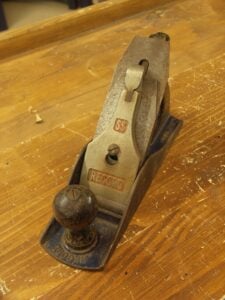
This is from my working experience having owned them and replaced them with a standard sprung steel cap iron. I admit that the removeable chunk of steel seems like a practical application patented by Record in the 60s. reality is it is of very minimal value for the general woodworker and little value to the specialist too. As for the term stay-set. This gives the impression that the plane stays set when you remove the iron assembly as a unit, sharpen the iron and replace it in the plane. How can that be when you take the iron out, reduce it in length and offer it back the wood without adjusting the depth wheel? It can’t.
Another thing. Record planes were never known for their fine machining. They were simply good working class planes and that’s that. There was plenty of whiplash in the mechanisms and also in the yoke. That never bothers me. When broken-in, the adjustment wheels spin in a fraction of a second and take up all slack in the thread faster than you can turn the tight threads of better made planes.
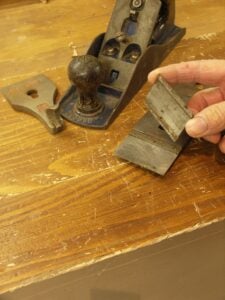
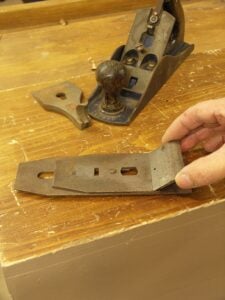
.
Clifton UK is the only maker of Stay-set irons that I know of. They follow the same form of manufacture as the old Record Stay-Set cap irons.
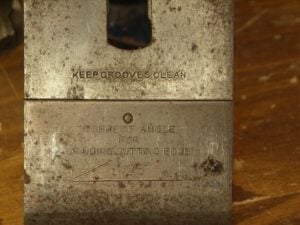



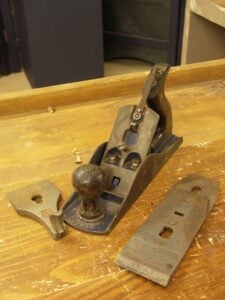
Thanks for the comment, I was looking to get hold of one of these to give it a try, looks like I would be wasting my time, I notice from your video’s on youTube, that you seem to prefer a Bedrock, I don’t have one of these, they do look very well made, they seem to be very much like Union planes, a company Stanley bought out in the very early days. For a beginner like me would you recommend the likes of a Bedrock style of plane or for that matter an earlier design along the Norris / Spiers style of Dove Tail construction, I have heard some of my friends speak very highly of these, is it mainly down to a tight mouth or are many more factors at work here than I am taking into account. I look forward to more of your instruction video’s, I have found them a great help.
On another note, of all the planes I have bought over the past few years perhaps 50+(second user examples mainly from eBay) none have had wings, a great tip, many thanks keep them coming .
No, I don’t really like Bed Rock plane types no matter the maker; just for clarity. I have no preference for Bed Rock planes at all, it’s Bailey I have preference for. Even when Bed Rock planes hit the market after their genesis production run Stanley couldn’t sell them very easily because the difference was so marginal you couldn’t rate one higher than the other. Today, manufacturers have made these planes superheavy with thick irons and heavier castings in ductile iron. Complete overkill for normal woodworking and very expensive too. You may be mistaken about my YouTube video and think that I said Bed Rock instead of Bailey. I am a Bailey man through and through. These planes really work as well as any finely tuned, sharpened and set hand plane.
I like the Stayset. It makes “little and often” honing just that bit easier. Flattening just the end of the face is good enough. You have to adjust it sooner or later of course, and the plane doesn’t “stay set” all that well, but it’s a time saver.
I also feel it nips the blade a bit better.
One of the few “after market” in improvements worth considering – but they are not essential.
I also like Record planes and far prefer them to Stanley/Bailey. In my experience, the SS Records work very well, were pretty well machined (perhaps not to the standard of Clifton or LN these days) and can be made to work very well. The Stayset capiron seems to offer better support than the thin capirons used on other planes. I wouldn’t part with my SS planes. I have had several Stanleys but have never got them to work as well as ther Records. Might be just luck, but I wouldn’t knock Record. Others think this too, which is why they often demand a higher price on auction sites.
It’s funny you should post this because I was just thinking today that in my experience neither Record nor Stanley were actually better than each other. Sorry to be contradictory here. Both can be fettled to the same standard but neither UK makers of Stanley or Record have ever in the history of the two companies come close to the engineering standards of Lie Nielsen or clifton. Stanley does obviously deserve all credit for being the forerunner to all. I suppose all of the others were really knock-offs of Stanley at the end of the day. I don’t really prefer Stanleys over Record or vice versa and I pick one or the other up depending on which bench I am at. I have ( I have twelve all with a full tool set cos of the school.). I should also say that I haven’t at all found Stayset cap irons advantageous in any way either. I still find them a bit fiddly actually. I say this because I don’t want anyone feeling that one is better than the other and be put off either one. I should also say that, yes, you can always get the same results with either a Stanley or a Record as you can with a Clifton or a Lie Nielsen.
Hi Paul and thanks for your comments. Perhaps I have just not struck it lucky with Stanleys and I’m sure you have used many more than I have. One further comment, I made 3 mm thick capirons for two of my Record planes (non SS) after reading that rigidity of clamping was important somewhere. I was convinced, after fitting these that the planes felt different, more solid and they seemed to handle difficult grain more easily, maybe it was just the better contact at the end of the capiron rather than the thicknes, I don’t know. I’ve recently bought a new Clifton 5 1/2 plane and when I compare that with my #6 Stanley, its quite a different experience. I’ve spent a good few hours now trying to get that Stanley to behave, flattened the sole (which wasn’t very flat), fiddled with the mouth, flattened the back of the blade etc, but I can’t get it to do what the Clifton will. Perhaps my #6 is just a bad example (I have a couple of not so good #4s as well, as I said, maybe I have just had a bad run) but to me, the SS Records and the Clifton have a different feel to them and are very satifying to use. All the best.
Paul, you are the boss with the hot sauce, if I may just get that out of the way since I am a first-time commenter. I appreciate your insights and experience no end. Thanks for sharing.
A bunch of years ago I got a couple modern Stay-Set cap irons from somewhere, I guess my friend Carl ordered them for us. They must be of Clifton manufacture, since you mention. I loved the concept. I still do. I agree that one can’t replace the iron, after sharpening, in almost any plane to the same spot within the tolerances demanded by a fine shaving, but the Stay-Set idea still has some values notwithstanding. One less operation when sharpening (two, really, since the cap iron must be replaced as well as removed). That is appreciated. Another thing: many conventional cap irons do not perfectly touch the iron at both ends of the “hump”, some are overcompensated to contact the knife edge first against the iron at the business end with only air attempting to press the iron flat on the frog, and hold it rigidly there against chatter. No lever cap will press the cap iron flat in those circumstances. With say, a 25 degree primary bevel on the iron and a fine setting to curl the chip, the pressure is cantilevered out past the point the iron leaves the frog, and I am quite sure springs the blade off of the frog enough to allow it to become excited, or chatter that is, when the grain is not sweet. I mean, it can be seen quite plainly on some tools I have owned.
The Stay-Set fights that. The iron lays flat on the frog, no question, and is not tempted to arch up and bedevil you.
My beef with those units of mine is that the flat portion of the removable half is not parallel to the frog, but presents a wedge shape to the lever cap. This forces any adjustment of depth to increase or decrease drastically the pressure applied by the lever cap, making difficulties. A disappointment, I can tell you.
Yours, Lee Haelters
Hi Lee
Not sure if its good form to interject on someone elses blog – not up on blog etiquette, so forgive my intrusion…anyhow, I just had a look at my small collection of SS and Cliftons and in general, the Stay-Set part is in line with the rest of the cap Iron which is what the machined channels are supposed to achieve I guess. So mine don’t seem to have the wedge problem you mentionand the pressure on the lever cap doesn’t change noticeably on any of them. Can you grind the end of the capiron to make it line up better (if it is sloped that way)? If they are Clifton, then they will be marked as such so if they are not right, I’d go back to Thomas Flinn who are, IMHO and experience, very helpful.
I was using my favorite SS #4 last night and thought to myself, again, what a pleasure it is to use and adjust.
Cheers
Richard
Unless you try to sharpen with a bench grinder, the amount of steel removed just to keep a blade razor sharp, is minute, the ‘shortening’ of the iron practicly nil. Flattening the back is simply done with SS and only serves to remove the (theoretical) burr at the cutting edge, not the whole back of the cutter. Think of (very) skilled carpenters, if not cabinet makers of yesteryear that honed their cutters frequently during the day just for that razor-sharp edge.
The principle was little understood then and even lesser now, and many owners changed to a regular cap iron when that little part of the two-piece assembly went awol, facing extra costs to replace. Hence many planes with the SS moniker, but with a regular cap iron, so be aware of this when trollin’ the ‘bay.
While I am not capable to hone by hand satisfactory, nor need to do so several times a day, I still enjoy the increased mass and stifness (3 instead of 2 pressure points on the cutter) of the Stay Set cap iron, a practical invention considered Record’s answer to the (claimed) advantages of the Bedrock series.
It left the Record brochures in the early 60’s, but it did return on the Clifton planes and the one Calvert plane, for more than a gimmicky reason I am sure
My two pence: I also like stay set irons for a smoothing setup, but agree they certainly aren’t essential. Although I have enormous respect for Paul, I think there is a misunderstanding here about what “Stay set” implied/promised. It only implies that the set of the cap iron will be approximately the same when replaced on the blade, not that the depth setting of the cutter will be maintained when the blade etc is placed back in the plane body after sharpening. As such it only saves a bit of time and fiddling if you are frequently setting the cap iron very close to the cutting edge as you may in “smoothing mode”
According to ‘Planecraft’ (written by C.W Hampton of record fame) the ability to retain the cap-iron setting was one advantage, with the other being increased rigidity due to three points of contact applied (vs two) when the lever cap is tightened.
I agree. Also it’s not necessary for the whole of the face to be honed flat – this would make sharpening a nightmare. Just a 10 mm or so behind the edge will do.
At Richard Lloyd: a little late to be getting back to you, sorry, but I got a notification for the first time that this thread had been added to, looked it up, and am glad to rejoin a conversation. I have found that I can search on my name and revisit any comments I have made to update myself on what people are saying! Ain’t technology great?
I can see for myself from the last photo here that the Record cap iron is, indeed, parallel to the iron as it should be, and why. In addition to the milled channel, there is a step in both pieces to the proper dimension. The pieces I have (or rather, had, as I haven’t seen them for some time) just weren’t dimensioned rightly, I guess. At the time, I supposed that when the maker milled the sharp end, he deliberately induced the slope by milling extra low and parallel to the table, so that shavings wouldn’t enter a tightly pressed cap.
No markings on those that I remember, so I guess that they weren’t by Clifton; maybe they were made by a cottage industry type machinist. L
The nazi plane!
Stupid joke sorry, I couldn’t resist 🙂
Paul, funny you should say this, as in peculiar coincidence, as moments before I saw notification of your comment I had been thinking of scenes from the movie “Dunkirk”, which I have just experienced. The scenes of a Spitfire pilot dueling with a “Nazi plane” (an Me109) were still going through my mind. That is a really fine movie for the those interested.
Oh, I just got it! SS! Duh! I was all set to write about a professor of architecture’s comment to me about a certain other architect, quite some time ago, whom he thought was Fascist. By that, he meant that the users of his proposed cities would be forced to accommodate the layout and planning of his creation, rather than the other way ’round. Somehow, I was going to draw a parallel to your comment. Classic overthinking.
In “Dunkirk”, I did love the depiction and dialects of those wartime Britons, wearing their coats and ties, and their stoic responses to those incredible challenges. Finest generation.